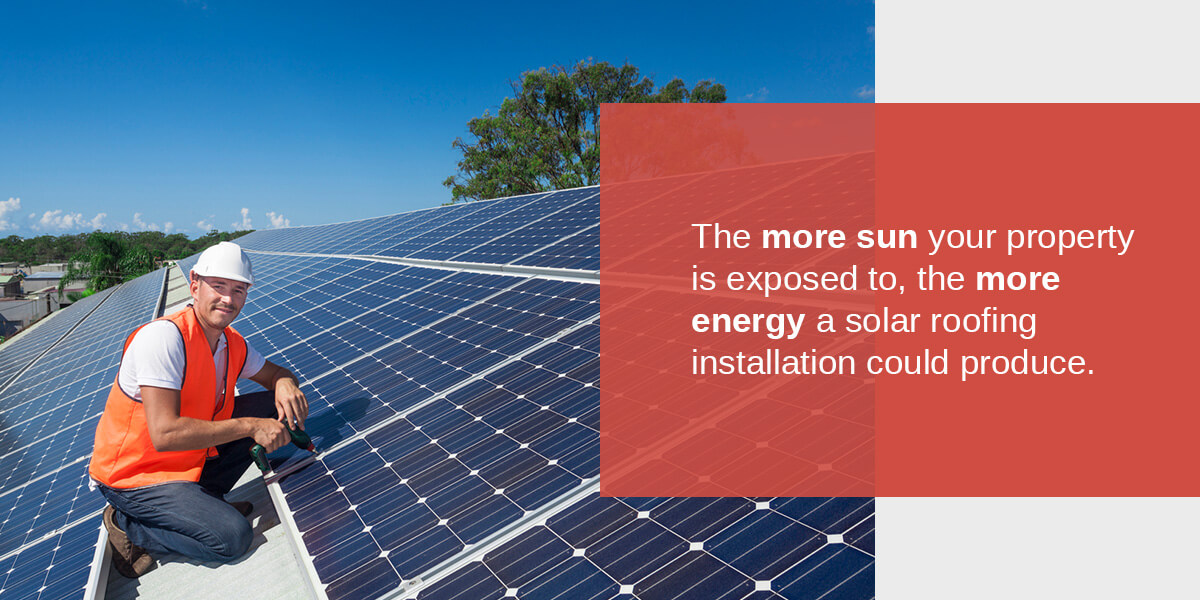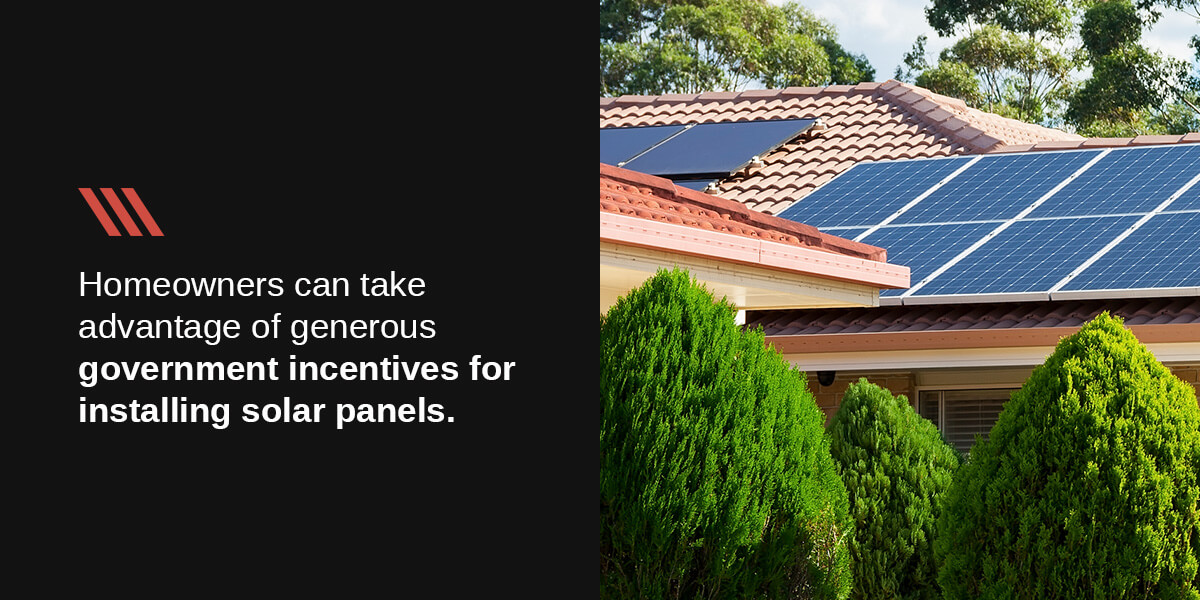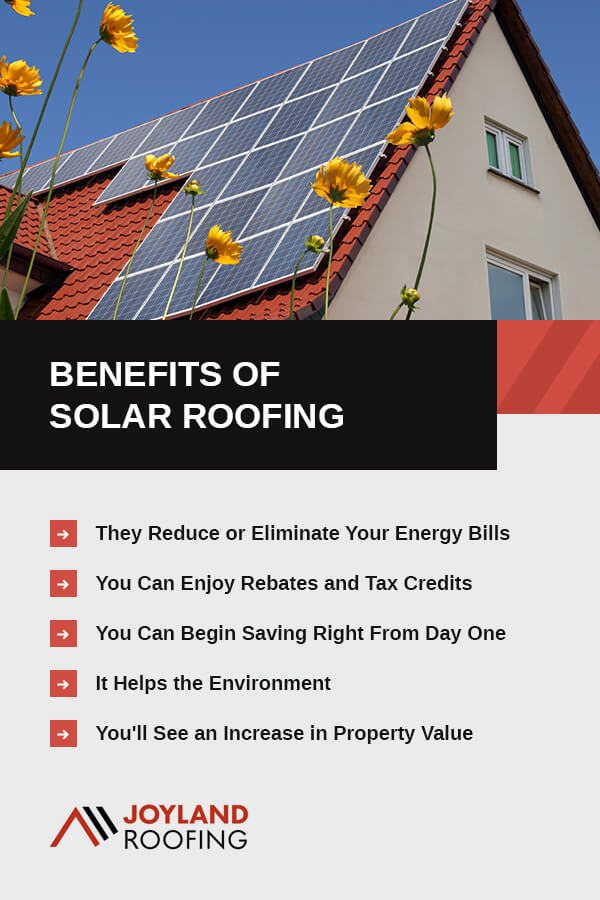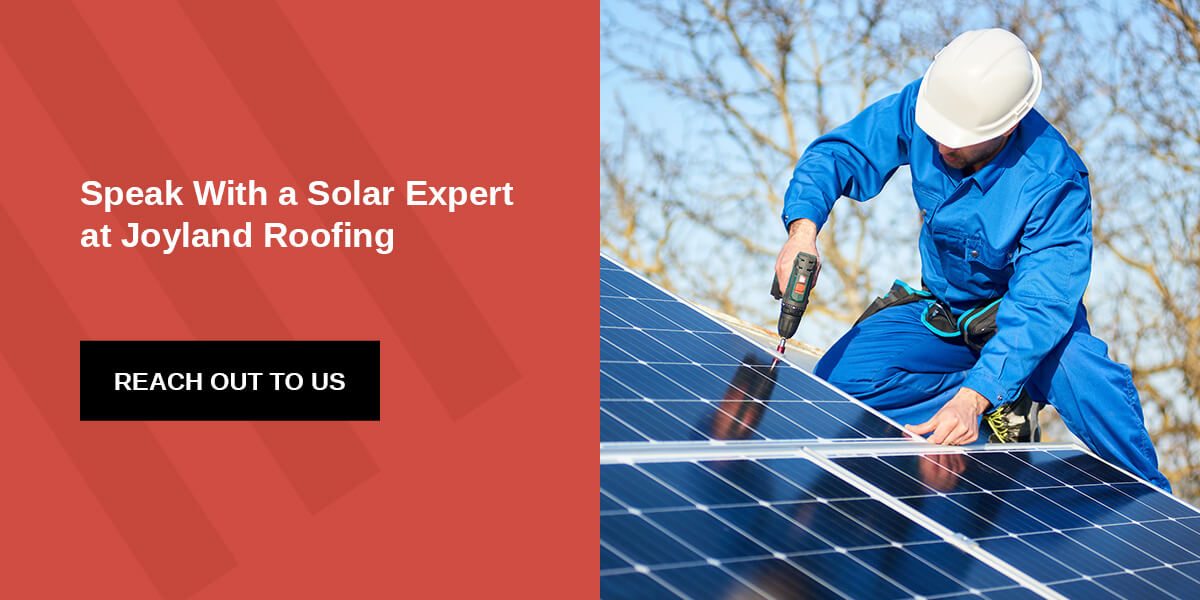Electricity from traditional sources is becoming more expensive, which is why many homeowners have switched to solar. However, whether you’ll save money by installing solar panels will depend on a number of key factors. Before making the leap, find out how your incentives and location may be able to save you money over time.
The cost of a solar roofing installation will vary based on the pricing of your local solar roof contractor, with factors such as your roof’s size, slope and pitch also playing a role. Contact your local solar panel installer for more information on pricing, as they’ll know best what you can expect based on the unique factors that affect your project.
How Long Will It Take Solar Panels to Pay Off?
To determine the payoff of solar roofing in your situation, go through the following steps:
1. Look Over Your Electric Bill
Solar panels generate power and can greatly offset, if not eliminate, your electricity costs every month. The more you’re paying every month for electricity, the greater the chance that you’ll benefit from switching to solar. However, keep in mind that the main charges on your statement, which are usage and electricity rates, are volatile. Check to see how much you are paying per month by averaging out your total yearly cost on a monthly basis. This is done by taking the yearly total cost, and dividing by 12.
If the electricity prices of a utility fluctuate, the amount you save could fluctuate as well. In a similar fashion, if the amount of energy you consume varies, the amount you save could change from month to month.
2. Determine How Much Sunlight Your Roof Gets
The more sun your property is exposed to, the more energy a solar roofing installation could produce, which results in a greater possibility to save money by switching to solar. Certain states like California or Arizona receive lots of sunlight, while states in New England receive significantly less.

How your home is oriented toward the sun, how shady your property is and the type of roof you have will also affect the output of your solar system.
In the mid-Atlantic area where we’re based, there are a few important factors to reckon with:
- Shading: Solar systems need direct sunlight to produce energy. This means that if the roof section you’re considering installing solar on is shaded at some point during the day, you will see a loss in efficiency and energy generation. You may need to consider having trees removed as a part of your solar installation process.
- Orientation: Since the sun is always towards the south here in Pennsylvania and the surrounding region, you want the roof planes to be facing as much towards the south as possible. The more directly south-facing the roof plane is, the more direct sunlight it will get. Southeast- and southwest-facing roofs are fine also, but we typically stay away from north-facing roofs because that’s where you begin to lose significant energy generation benefits.
A simply and helpful resource to determine the eligibility of a roof surface for solar is Google’s Sunroof Project. The more yellow the roof surface shows, the better it is for solar!
3. Estimate How Much It Will Cost to Get Solar Panels
Most of the cost of solar roofing is in buying the panels themselves and paying a professional to install them. However, the low long-term expenses can compensate for the higher upfront costs — most solar panel systems don’t need much maintenance and are meant to last three or more decades with minimal changes in terms of the amount of electricity they produce.
When you calculate the total cost, think about the amount of energy you commonly use, which you can find on your monthly utility bills. You must also consider the size of the system that you will need to generate the amount you use.
According to the Center for Sustainable Energy, with installation, a residential 5kW-size system costs an average of $3 to $5 per watt, or between $15,000 and $25,000 — which is the cost before any incentives or tax credits. If you know how much your current energy usage is, you will be able to calculate the amount you’ll need to pay for your solar panels.
Once you’ve done the above calculation, shop around for solar panels the way you would for other major purchases, such as a car. Remember that companies sometimes offer lower installation costs in the form of rebates and other types of programs.
Get quotes for a handful of contractors, then look for customer reviews, Better Business Bureau profiles, certifications and other information so you can find providers that are reputable.
4. Search for State, Federal and Other Incentives
Homeowners can take advantage of generous government incentives for installing solar panels. For instance, there is a residential federal tax credit that lets taxpayers claim 26% of installation costs if the system is placed in service by the end of 2022. In 2023, this credit goes down to 22%, and it will expire in 2024 unless it’s renewed by Congress.

This federal tax benefit cannot be refunded, which means you can’t get the savings in the form of a check. However, you can lower — or perhaps even eliminate — how much you owe on your annual taxes.
There are other credits available, but they vary from location to location. Depending on the state you live in, you may be able to enjoy additional incentives like property tax exemption, cash back, expedited permits and waived fees. Some states even allow homeowners with solar panels to sell excess power back to their utility company. Research the credits that are available to you in your state by looking over the database of your state’s incentives for efficiency and renewables.
It is important to stress that these benefits won’t necessarily last forever. After all, solar is becoming cheaper and cheaper, which means city and state governments and utilities are reducing the number of available incentives. If you wait too long, these incentives may disappear entirely.
5. Take Note of Applicable Trade Policy
When government trade policy changes, prices may see significant adjustments as well. In January 2018, President Trump imposed a four-year tariff on imported solar panels and solar cells. This tariff began at 30% and was set to go down by 5% every year until February of 2022. In 2020, the rate for the fourth year was increased by 3%, from 15% to 18%.
The 2018 increase in the tariff rate resulted in a higher price per watt for average consumers. However, as the tariff is continuing to diminish and solar technology produced both domestically and abroad is becoming more available and affordable, the overall outlook is positive.
6. Consider All the Factors and Make a Decision
If the area where you live has high energy rates, your home is a viable candidate for solar roofing installation and you can afford the upfront costs, it’s a wise decision to install solar panels while the 26% tax break is still available — both for the environment and your finances. Your power bill won’t be eliminated overnight, but you will begin to see benefits quickly.
You also need to be sure you’re selecting a solar panel installation company that can get the job done the right way, the first time. Poor workmanship can increase a roof’s risk of leaking depending on how the panels are attached to the shingles or roof itself. Be sure you’re selecting a reputable company with a track record of success. You want your new solar panels to save you money and increase your energy efficiency — not lead to leaks and expensive repairs.
If you’ve made the decision to buy solar panels, do some shopping around and look for good incentives. Keep in mind that you can also lease solar panels, which makes the upfront cost of solar roofing more manageable. Just remember that because you wouldn’t own the panels, they won’t increase your home’s value and you may not qualify for incentives.
Benefits of Solar Roofing
Solar panels are an excellent way to offset your energy costs, lessen your home’s environmental impact and secure numerous other benefits, which include supporting a local business and making a contribution to energy independence.

Below are five of the most important benefits of solar panels:
1. They Reduce or Eliminate Your Energy Bills
One of the greatest financial benefits of solar energy is the lower utility bills, which you can take advantage of even if you live in a cloudy region. Though homes in some areas of the U.S. aren’t known for their sun exposure, even cloudy zones generally receive at least two hours of sunlight every day. A sunnier environment might receive over five hours on average, giving a solar roofing installation plenty of opportunity to pay off its cost.
Although sunny weather will lead to higher solar energy production, solar panels will still draw energy when the sun is hidden by clouds. Cloudy weather produces anywhere from 10% to 20% of the power that is generated by direct sunlight.
2. You Can Enjoy Rebates and Tax Credits
As mentioned above, the government is offering generous tax credits for solar installation, which gives a significant percentage of the total system cost back to you when it comes time to file your taxes.
Combined with local and state rebates and Solar Renewable Energy Credits (SRECs), you can cut your total costs in half. SRECs are generated throughout the year, and they can also be sold to utility companies to give you a significant return on your initial investment.
Examples of other incentives include programs that help low-income homeowners with solar installation. There are also providers that offer a free installation, where they pay for the panels and setup, and then charge for electricity at a reduced rate. They’re essentially “leasing” the space on your roof, collecting the proceeds from any SRECs and giving you electricity at a lower rate in exchange. If you’re not willing to make the initial investment or would like a no-money-down option, this is a good avenue to consider.
Regardless of where you live, there are most likely some generous solar tax credits you can use to your benefit. Just make sure to do it before they go away!
3. You Can Begin Saving Right From Day One
The annual cost for electricity can be thousands of dollars. In fact, the energy expenditure for the average homeowner is over $3,000, which includes residential and transportation energy. With solar power, you can lower or even eliminate some of these costs once the installation is complete. Solar roofing solutions also provide you with long-term savings, as capturing the sun’s power is basically free.
When installed correctly, solar panels will also prolong the life span of your roof by helping protect it from the elements, including rain and snow. They also make your home more energy-efficient when it’s hot outside, as the hot sun isn’t beating down on your roof directly — instead, the panels are absorbing the sun’s heat, allowing the house itself to stay cooler. The extended life span and increased energy efficiency mean you get to keep more money in your pocket every month after the initial investment in solar panels.
4. It Helps the Environment
Solar panels absorb pure, clean energy from the sun. By installing solar panels on your roof, you can help in the fight against greenhouse gas emissions and make society less dependent on fossil fuels.
Traditional electricity is sourced from coal, natural gas and other fossil fuels. When these fuels are burned to generate electricity, harmful gases are emitted in the process, and these gases constitute the leading contributor to air pollution around the world. Fossil fuels aren’t just harmful for the environment — they’re also a limited resource. As a result, the price of electricity constantly fluctuates, which can lead to increases over short periods of time.
Renewable energy is also good for public health, as natural gas and coal plants emit water and air pollution that can cause harm to humans. While producing electricity from fossil fuels requires large amounts of water and can lead to water pollution, solar energy doesn’t require any water to operate. Solar power is doubly beneficial in this respect because it doesn’t pollute natural resources or put a strain on the Earth’s water supply.
Solar power also continues to work during a heatwave or drought. Natural gas, coal and nuclear power plants require large amounts of water for cooling, which means that a heatwave could threaten electricity production.
What’s more, solar panels create clean energy jobs. The United States has long been a leader when it comes to clean energy, a position it will hopefully continue to maintain as more companies move to renewable energy sources.
5. You’ll See an Increase in Property Value
Another reason to invest in solar panels is that you’ll likely see an increase in your property value when you do. A solar panel system is like a renovated kitchen or finished basement — it makes a home more desirable on the real estate market. As a result, buyers are willing to pay more for homes with solar panels. In fact, homes featuring photovoltaic solar cells have historically commanded a premium of about $15,000.
Homebuyers usually understand the significance of seeing a home equipped with solar, especially because the system has already been installed and they won’t need to make the initial investment. Plus, homes with solar panels sell for more because buyers know they’ll be cheaper to own thanks to energy savings and net metering. The same homes also sell faster, spending less time sitting on the market due to a homebuyer preference for energy-efficient and environmentally friendly housing.
Differences Between Solar Shingles and Solar Panels
If you’re trying to decide between traditional solar panels or the newer technology of solar shingles, it’s a good idea to consider the pros and cons beforehand. Advantages of solar shingles include:
- More attractive: Solar shingles are more aesthetically pleasing than solar panels.
- More cost-effective: If you happen to be replacing your roof anyway, you may want to opt for solar shingles, as they are more cost-effective per watt of solar energy.
- Reinstallation compatibility: If you ever plan to move, solar shingles can be removed and installed again.
However, there are also a few ways in which solar shingles cannot measure up to traditional solar panels, which include:
- Less efficient: Solar shingles are sometimes not as efficient as regular solar panels, which often produce more energy per watt compared to the cost of the installation.
- Require specific roof conditions: For solar shingles to be effective, you’ll need a specific slope of roof with lots of exposure to sunlight.
- Shorter life span: Solar shingles tend to lose their ability to function more quickly than solar panels.
- Limited availability: As solar shingles are still a relatively new technology, not all solar companies install them.
Speak With a Solar Expert at Joyland Roofing
Joyland Roofing installs solar panels throughout Southeastern and South Central Pennsylvania. Whether you are hoping to replace your whole roof system before you go solar or just want to begin saving on your energy bills, we would be happy to speak with you. We can discuss whether your roof is a good fit for solar. Reach out online to get in touch with our team or give us a call at 717.459.3499 to learn more.
Pennsylvania Home Improvement Contractor License (HIC) # PA124258


